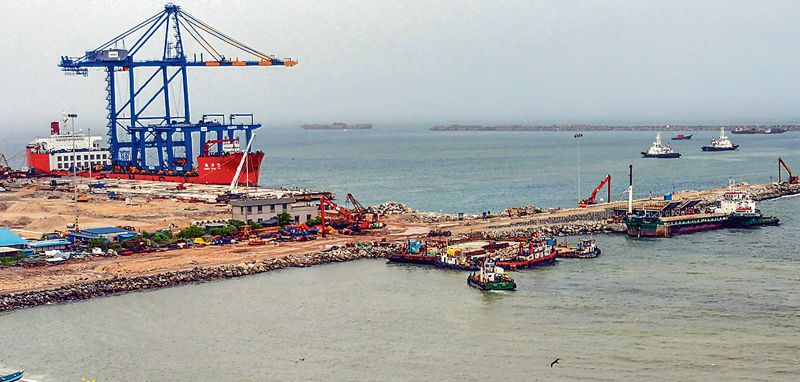India’s port development sector took off only recently. The late arrival of Vizhinjam reflects strategic shortsightedness of successive govts.


EARLIER this week, Iran-backed Houthi militants claimed that they had launched a drone attack against an Israel-linked cargo vessel in the Red Sea region. The Gaza war has expanded, hitting international shipping. The previous week, four of the world’s largest cargo shipping companies had stopped transiting across the Red Sea, diverting shipping via the longer Cape of Good Hope. On December 19, the US announced an International Response Force, including Seychelles, to meet challenges in the Red Sea.
The closure of the Suez Canal is a possibility; this will result in disruption of supply chains, an increase in the cost of ocean freight and a hike in oil prices and insurance bonds. For India, it is a double jeopardy: the absence of a 20-metre-deep trans-shipment port to handle large cargo containers and oil tankers. Vizhinjam, India’s first deep-water container terminal (inaugurated on October 15), is not yet fully operational. Until now, large containers were being taken to ports in Sri Lanka, the UAE and Singapore, where cargo was trans-shipped on smaller vessels to ports on the Indian coastline. Currently, most container ships skip Indian ports due to poor infrastructure and high tariff.
Vizhinjam, near Thiruvananthapuram, dredged to increase the depth from 18 to 20 metres, is located 10 nautical miles from international shipping routes. About 80 per cent of world trade moves by sea; in case of India, it is nearly 90 per cent. India’s lethargic maritime outlook has failed to devise either a maritime policy or strategy. While the Indian merchant shipbuilding industry is stagnant, its port-handling capacity is limited. Had India developed deep-sea ports, large ships and containers could have been berthed and trans-shipped locally rather than being sent to foreign ports.
India’s port development sector took off only recently. The late arrival of Vizhinjam reflects strategic shortsightedness of successive governments and lack of Centre-state cooperation. The Indian Navy had projected the need for a deep-sea port as early as the late 1980s when I was with the Defence Planning Staff. The project was revived during the rule of UPA-II and it was in 2015 that the Vizhinjam port was awarded to the Adani Group with the unrealistic timeline of 2018 for completion. It took another five years of wrangling — domestic politics, conflict between national and local interests and lack of experience — to complete the first phase of the project. What’s ironical is that Chinese merchant ship Zhen Hua 15 arrived at Vizhinjam in October this year, bringing giant cranes from Shanghai for cargo handling. It was the first ship ever to dock at Vizhinjam and that too a Chinese one, more than three years after the Galwan clash between Indian and Chinese troops.
The Adani Group has acquired six ports in the past 10 years and now reportedly has a port every 500 km along India’s coastline. It has a total of 14 ports and terminals which handle one-fourth of the cargo passing through the country’s ports.
The acquisitions have catalysed strategic thinking about seaports, including foreign ones, in an era of war and Black Swan events so as to extend India’s strategic footprint in the Indian Ocean. In January, the group acquired Israel’s Haifa port — which is in sync with the proposed India-Middle East-Europe Economic Corridor — despite its conflict-prone reputation. The Colombo West International Terminal, acquired last year after much toing and froing with Sri Lanka, enables India to monitor Chinese activities in Colombo’s Eastern Terminal, China-built Colombo City and Hambantota port. The group aims to become a 500-million-tonne port company by 2025 and raise the Vizhinjam port’s cargo capacity to 1 billion tonnes by 2030.
The western Indian Ocean off the East Coast of Africa is piracy-infested, though it has been somewhat dormant lately due to EU/UN anti-piracy operations. Earlier this month, an Indian warship trailed a pirate-hijacked steamer in that area. For India, the key contestation is with China. The latter has acquired a sea base in Cambodia and the Kyaukphyu deep-sea port in Myanmar. China has also acquired the Gwadar port in Pakistan. It is eyeing sea bases in Vietnam; near Coco islands (Myanmar); near Chittagong (Bangladesh); and in Madagascar. It will seek one in Maldives after the regime change there and is also ensconced in Eritrea off the Red Sea. That’s formidable.
India, a late starter, has been less successful in securing foreign ports/military bases. Ayni in Tajikistan was its first acquisition. The Chabahar port terminal in Iran was acquired in 2014, Sittwe port (Myanmar) in 2014 and Agalega military base in Mauritius in 2020. Negotiations with Seychelles for a military base on Assumption Island went dormant last year or so. India missed out on Hambantota when it was first offered in 2007. Earlier this year, the government announced plans for a major trans-shipment hub in the Great Nicobar Island chain to activate the East Coast. The mega project will have an estimated investment of around Rs 41 lakh crore.
Prime Minister Narendra Modi announced this week that India would become the world’s third-largest economy during his third term. Expansion of ports and increasing their efficiency in handling cargo containers and oil tankers are vital. A string of military bases and usable port terminals are essential to deal with threats to India’s economic ambitions.
